TEN YEARS AGO TODAY!: 2014 HUSQVARNA TC250 TWO-STROKE
FIRST AND FOREMOST, IS THE 2014 HUSQVARNA TC250 BETTER THAN THE 2013 HUSKY TC250?
A: That is a trick question. Husqvarna has not imported a 250cc two-stroke motocross bike since 2009 (and if they had, it wouldn’t have been called a TC250 but a CR250). The only 250cc two-stroke in Husqvarna’s 2013 lineup was the WR250. It was an old-school two-stroke that was long in the tooth and destined for the scrap heap.
Instead of renovating the antiquated WR250, Husqvarna dropped the whole line and started over with all-new, albeit borrowed, bikes for 2014.
Q: WHAT ARE HUSQVARNA’S NEW MODEL DESIGNATIONS?
A: Previously, Husqvarna labeled its models as TC (motocross-based four-strokes), TXC (offroad four-stroke machines), TE (street-legal dual-sport bikes), CR (two-stroke motocross bikes) and WR (two-stroke offroad bikes).
For 2014, the Husky model designations, now being derived in Austria, have been changed to FC, TC, TE and FE. TC is for 85cc, 125cc and 250cc two-stroke motocross bikes (there is a TC300, but it is not offered in the USA). FC is the designation for Husky’s 250cc and 450cc motocross bikes (there is an FC350, but it is not offered in the USA). TE is for 250cc and 300cc two-stroke enduro bikes, while FE is reserved for 250cc, 350cc and 501cc four-stroke-powered enduro bikes.
Q: DIDN’T MXA BUILD A FULL-RACE HUSKY TWO-STROKE A COUPLE YEARS AGO?
A: Back in April of 2010, we took a Husqvarna WR300 and turned it from a mild-mannered trail bike into an effective motocross bike. It was not an easy build. We enlisted Pro Circuit’s Mitch Payton to port the cylinder, mill the head and build a special exhaust pipe. We got Wyatt Seals to send us one of Glenn Kearney’s 38mm Keihin PWK carbs to replace the stock Mikuni TMX carb. Since Husky had discontinued the CR250 motocross version the year before, we stole the ignition, black box and flywheel off a leftover bike. To get the kind of performance we needed, we dumped the flattop Husky piston and used a domed Vertex piston out of a Gas Gas 300. Luckily, the 2010 Husky WR300 came with Kayaba forks, so we valved them to our last Kawasaki KX250 spec (2004) with stiffer 0.44 forks springs. When all was said and done, we gained 5 horsepower over the stock WR300’s 42 ponies. Our total cost was $1500, but it required a lot of legwork to get all the pieces together.
In the end, our WR300 produced decent horsepower, but we were still stuck with a very heavy, antiquated bike and a wide-ratio gearbox. In our opinion, it was okay for a Husky, but our expenses pushed the bike into the $8500 price range. We could get a better bike for less.
Q: WHAT DID HUSQVARNA DO TO MAKE THE 2014 TC250 COMPETITIVE?
A: They had two engineers hold Husqvarna decals two feet apart, and a third engineer rolled a 2014 KTM 250SX between them.
Q: WHY DIDN’T HUSQVARNA BUILD ITS OWN PROPRIETARY 250 TWO-STROKE DESIGN?
A: KTM found itself between a rock and a hard place when it purchased Husqvarna from BMW in March of 2013. A quick perusal of the existing Husqvarna models didn’t sit well with KTM’s management team. Apart from the 2013 Husqvarna TC250 Red Head engine, Husky didn’t have anything that KTM felt they could use. Plus, KTM wanted to dump the Italian factory, along with the inevitable labor problems that come with Italian unions.
The solution was to move production from Varese, Italy, to Mattighofen, Austria. In the process, KTM left behind a brand-new, high-tech production line, put in place at great expense by BMW, as well as any vestige of Husqvarna’s old bikes, including the Red Head engine.
The timing of the purchase couldn’t have been worse for the 2014 model year. If the new Husqvarna group took the time to design all-new bikes, they would not have had any bikes in the showrooms in 2014 (and probably not in 2015, either). So rather than skip 2014, they cherry-picked their way through the KTM catalog—this is basic platform sharing, very common in the automobvile industry.
It is no secret that under the hood of every 2014 Husqvarna lies KTM running gear. Perhaps in the future, Husky will flex its muscles and build creative new products. But, we will take what we can get, because without KTM stepping in to take over, Husqvarna’s 103-year history as a motorcycle manufacturer would most likely have come to an end—because BMW wasn’t interested anymore.
Q: WHAT IS THE DIFFERENCE BETWEEN A HUSKY TC250 AND KTM 250SX?
A: The MXA wrecking crew was able to identify 13 differences between the KTM 250SX and Husky TC250.
(1) Color. The Swedish flag is blue and yellow, so to distance Husqvarna from its Italian era, the Austrians went with white plastic adorned with blue and yellow graphics (and yellow fork guards). The Austrians do have a Swedish connection in that they ran the Husky spin-off brand, Husaberg, from 1995 until today. It should be noted that the Husaberg’s color scheme was also blue and yellow. KTM will shut down Husaberg at the end of 2014 to focus on Husqvarna.
(2) Plastic. Not only is the Husky’s color different, but the plastic parts are unique to the brand.
(3) Gas tank. Although it looks like a KTM gas tank, there are enough differences that KTM radiator wings will not fit.
(4) Subframe. Husaberg was the stalking horse for the idea of an injection-molded polyamide composite subframe (it’s okay if you say “plastic” or “nylon”). The 2014 Husqvarna’s plastic subframe is much less involved and better designed than Husaberg’s cumbersome frame, but it is untested on American-sized jumps.
(5) Airbox. Largely because of the plastic subframe, the airbox cover on the TC250 had to be reconfigured to fit. On the KTM it is much smaller, while on the Husky it encompasses the complete left-side panel and number plate. Additionally, Husky has a spring-loaded plastic clamp holding the air filter in place, while the KTM uses a wire clamp.It doesn’t breathe very well.
(6) Rims. The 2014 KTM motocross bikes come with low-cost OEM versions of Excel rims. The 2014 Husqvarna TC250 is equipped with black-anodized D.I.D. DirtStar rims. DirtStars are below the LT-X and ST-X rims in the D.I.D. product line, but, in our opinion, we rather have them than the silver Excels on the KTMs.
(7) Rear axle. Starting with the 2013 model, KTM upped the rear axle size from 20mm to 25mm, so we were surprised to see that the 2014 Husqvarna TC250 still had the 20mm axle. Perhaps it isn’t that strange, though, since the Yamaha YZ250 and YZ125 have smaller axles than the Yamaha four-strokes. You can’t use the big KTM axle because the axle blocks on the swingarm are too small.
(8) Hand guards. Every 2014 Husky comes with hand guards.
(9) Grips. The grips have “Husqvarna” embedded in them in case you forget what your $7200 bought.
(10) Ignition maps. The KTM 250SX two-stroke comes with two maps, but to access the second map you have to disconnect a plug hidden under the left side of the gas tank. On the Husqvarna TC250, the maps can be changed via a switch on the handlebars.
(11) Seat bolts. KTM seats are held in place by one bolt from underneath. The 2014 Husky TC250 uses two seat bolts (hidden inside the hand holds). Why did KTM change the seat-mounting system? Because of the plastic subframe. Word of warning: Never lift your Husqvarna up by the rear fender—instead use the hand holds to avoid breaking the rear fender.
(12) Rear sprocket. The Husky comes with a black 48-tooth rear sprocket, while the KTMs have silver sprockets.
(13) Valve cover. Since the 2014 Husky TC250 two-stroke doesn’t have valves, it also doesn’t have a valve cover. But if it did, it would be powder-coated yellow.
Q: WHAT ARE THE PERTINENT SPECS ON THE 2014 HUSQVARNA TC250?
A: The technical specs are as follows:
Displacement: 249cc (7.6 cubic inches)
Bore and stroke: 66.4mm by 72mm
Transmission: Five-speed
Gearing: 13/48
Carburetor: 36mm Keihin PWK
Mapping: Dual switch-activated maps
Frame: Chromoly steel (ovalized)
Subframe: Injection-molded polyamide composite
Forks: 48mm WP closed cartridge
Shock: Link-actuated WP 5018
Head angle: 63.5 degrees (26.5 degrees)
Brakes: 260mm (front), 220mm (rear), Brembo master cylinders
Clutch: Hydraulic Belleville washer-sprung Damped Diaphragm Steel (DDS) clutch
Q: HOW FAST IS THE 2014 HUSQVARNA TC250?
A: It is just as fast as a 2014 KTM 250SX and not one iota faster; however, that is nothing to sneeze at, because the KTM 250SX had been the fastest 250cc two-stroke sold—and now it can’t claim that anymore.
This is the best 250cc two-stroke engine made regardless of which bike it is in. It hits hard and quick by four-stroke standards, but by the old-school way of thinking, it has a broad and easy-to-use powerband. However, since we no longer live in our previous two-stroke world, let’s just admit that it hits hard, revs quick and, in the hands of a maladroit rider, can wheelie and spin the rear tire.
At just a hair under 50 horsepower, and all of it is on tap now, as opposed to later, both the Husky, and the KTM it is based on, require a talented rider—not necessarily a fast rider, but one with two-stroke savvy.
Q: WHAT IS THE EASIEST WAY TO MAKE THE TC250 FASTER?
A: You need to consider buying the KTM 300cc PowerParts big-bore kit. The $950 kit comes in both enduro and motocross versions and includes a new cylinder, head, piston, rings, gaskets, power valve and black box. This kit is worth 5-1/2 horsepower in the midrange and 52 horsepower at peak. Also, we would drill holes in the airbox cover to help it flow more air.
Q: HOW DOES THE 2014 HUSQVARNA TC250 HANDLE?
A: Yes, four-strokes are easier to ride. They are like a Cadillac compared to the two-stroke Porsche. But, when it comes to making cuts, going into uncharted territory or breaking out of the preordained line, nothing can cut and thrust like a two-stroke (not even a Suzuki four-stroke).
Four-strokes are like race cars; they have one fast line around a track, and they must go there. If they deviate, they lose ground. Two-strokes are for deviants. They can give up on the outside line and carve a tight inside. Why? Because they are 20 pounds lighter and accelerate instantly. Their simple, lightweight, quick-revving engines can generate instant speed—and that makes inside lines work.
Two-stroke racers don’t have to follow the holy grail racing line. They can run up the inside, cut across berms and make surprise attacks where a four-stroke would never think they could. The caveat to all of this is that you have to put out the effort to make it happen. Lots of effort. The “attack mode” of the 1980s wasn’t just a term for where to put your elbows—it was a way of life.
Q: WHAT DID WE HATE?
A: The hate list:
(1) Suspension settings. Thanks to the light weight and rear-wheel handling of a 250cc two-stroke, the Husky suspension isn’t the worst we’ve ever tested—but it isn’t even close to the best.
(2) Seat foam. Yes, the Husqvarna does have a different seat from the KTM 250SX, but they use the same wimpy foam.
(3) Shock preload ring. We’ve never been able to convince the KTM engineers that their rubber preload ring is bogus. Maybe the Husky guys will be smarter in the future.
(4) Shift lever. It is too low in the stock position and too high in the next notch up. We bent it in a vice to be in the middle of the happy hunting ground—hunting for the next gear!
(5) Sprocket bolts. Check the rear sprocket bolts before every race.
Q: WHAT DID WE LIKE?
A: The like list:
(1) Rims. Husky used D.I.D. rims instead of KTM’s Excel rims.
(2) Price. Expect to spend close to $2000 less for a TC250 two-stroke than an FC450 four-stroke. That money could finance your complete racing season.
(3) Power valve. Even though the owner’s manual says not to touch the power-valve adjuster, you can and you should. In fact, order an $89.95 Kreft PowerDial from www.kreftmoto.com and adjust it in 10 seconds.
(4) Brakes. This is how every bike should stop.
(5) Hydraulic clutch. Husqvarna and KTM have great clutches—Honda, Suzuki, Yamaha and Kawasaki do not.
(6) Map switch. There are two maps on the TC250 handlebars. MXA always uses the stock map, but you can access the “soft” map by flipping a switch. Consider the map switch an impromptu IQ test, because one setting is good and the other isn’t.
Q: WHAT DO WE REALLY THINK?
A: You’d have to have been dropped one too many times as a child not to know that the 2014 Husqvarna TC250 is just a white KTM 250SX. But for our money, it is the more interesting, better equipped and not something that every second guy on the starting line will be sitting on. Plus, you get the security of knowing that technical info, parts and service can be found at either Husqvarna or KTM dealers.
MXA HUSQVARNA TC250 SETUP SPECS
This is how we set our Husqvarna TC250 up for racing. We offer it as a guide to help you find your own sweet spot.
WP FORK SETTINGS
For hardcore racing we ran this setup on the 2014 Husqvarna TC250 (stock settings are in parentheses):
Spring rate: 0.46 N/mm
Oil height: 370cc (380cc)
Compression: 7 clicks out (12 stock)
Rebound: 12 clicks out
Fork leg height: 5mm up (flush on a sandy track)
Notes: The cheapest way to fine tune the Husqvarna’s WP forks is to raise and lower the fork oil height to get the smoothest midstroke action without bottoming. Slower or lighter riders can lower the oil by 10cc (to 370cc) and faster heavier riders can raise the oil height by 10cc (to 390cc) The biggest complaint about WP forks is overly quick damping through the midstroke.
WP SHOCK SETTINGS
For hardcore racing we ran this setup on the 2014 Husqvarna TC250 (stock settings are in parentheses):
Spring rate: 5.4 N/mm
Race sag: 105mm
Hi-compression: 2 turns out
Lo-compression: 1 (15 clicks out)
Notes: We ran a 1.25mm longer Pro Circuit shock linkage. Not only did it lower the rear of the bike by 10mm, but it stiffened up the initial part of the shock’s stroke to help widen the range of the stock 5.4 shock spring. Faster or heavier riders might be required to go to the stiffer 5.7 kg/mm shock spring from the FC450 or 450SXF. If you are savvy, you will use free sag to make the decision for you.
KEIHIN PWK 36S JETTING SPEC
Husqvarna TC250 jetting has benefitted from KTM’s experience over the past few years. For 2014 Husqvarna and KTM carbs are spec’ed with the N1EH needle instead of the leaner N1EI used in 2013. As an added bonus, Husqvarna includes a richer N1EG needle in the tool kit for cold weather. Husqvarna sets the needle position at the 4th clip from the top. If you ride in cool weather consider going to a 160 mainjet and N1EG needle. We also swapped out the stock 42 pilot jet for the leaner 40. Here are MXA’s recommended jetting specs for the 36mm Keihin PWK carb (when changed, stock specs are in parentheses):
Main: 158
Pilot: 40 pilot (42 stock)
Needle: N1EH
Clip: 4th clip from top
Air Screw: 1-1⁄2 turns (2 turns stock)
Notes: Jetting is fairly good and, in fact, we ran this same jetting even when we installed the KTM Power Parts 300cc kit.


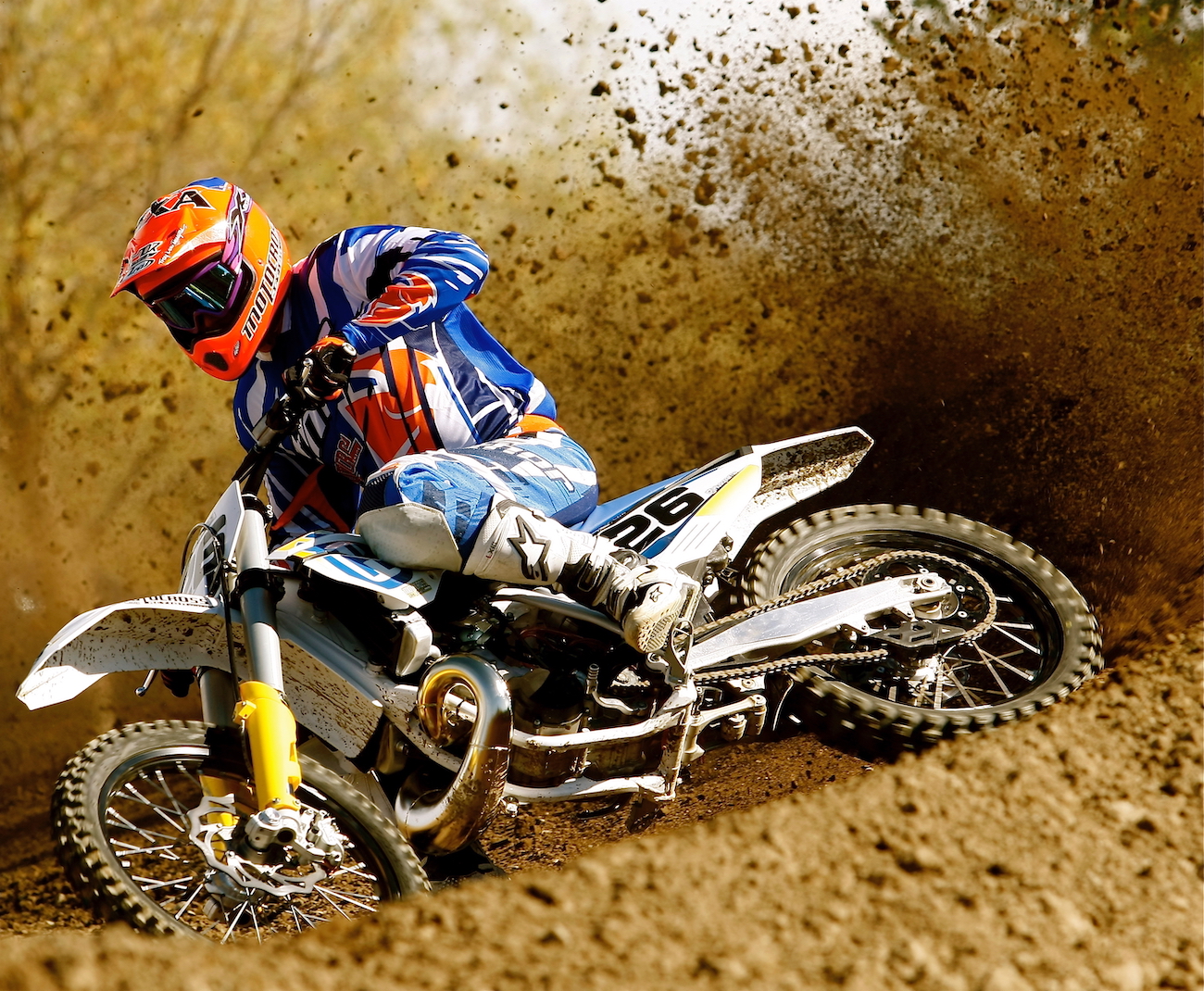
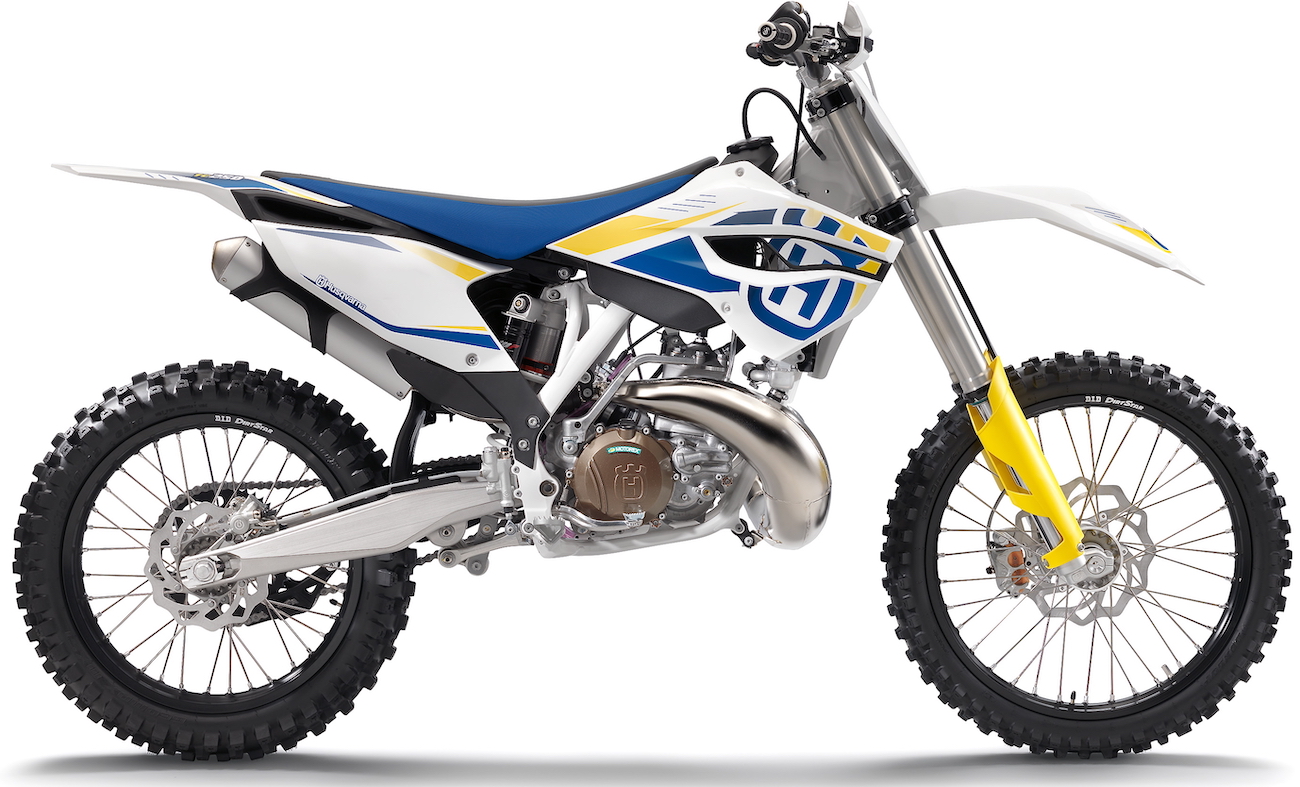
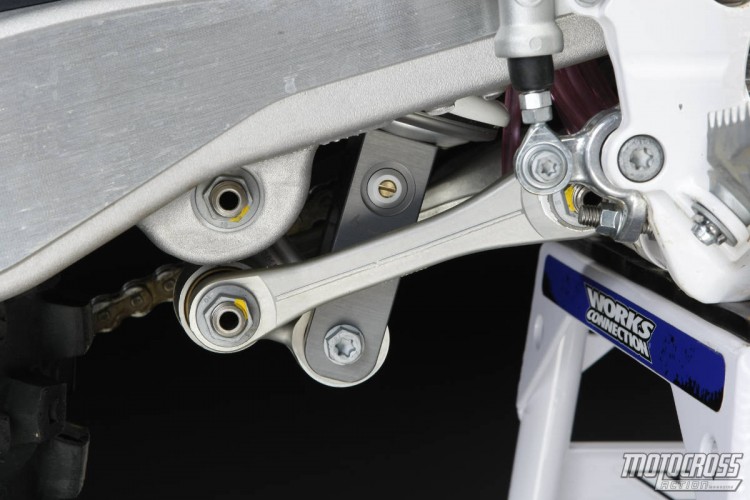
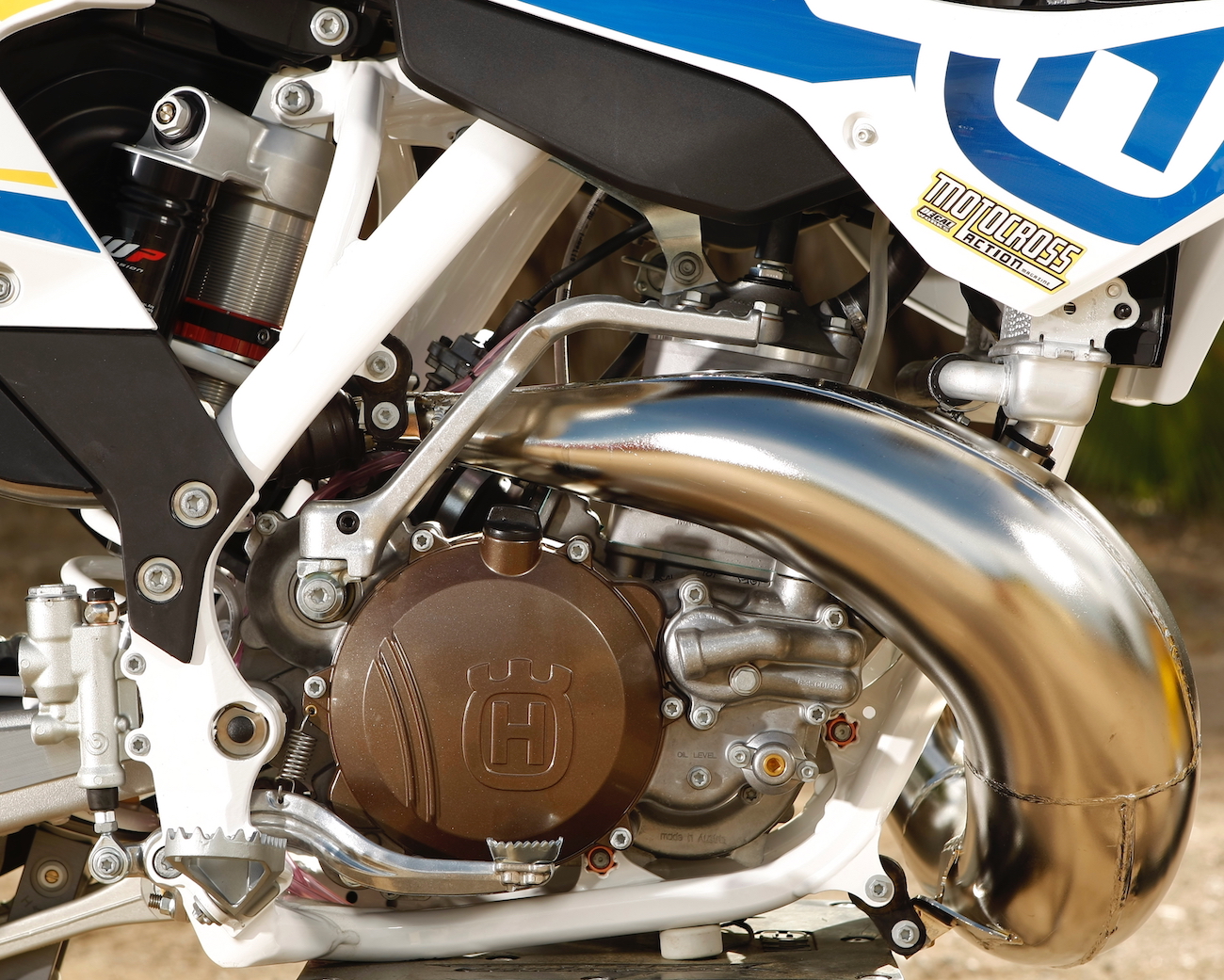
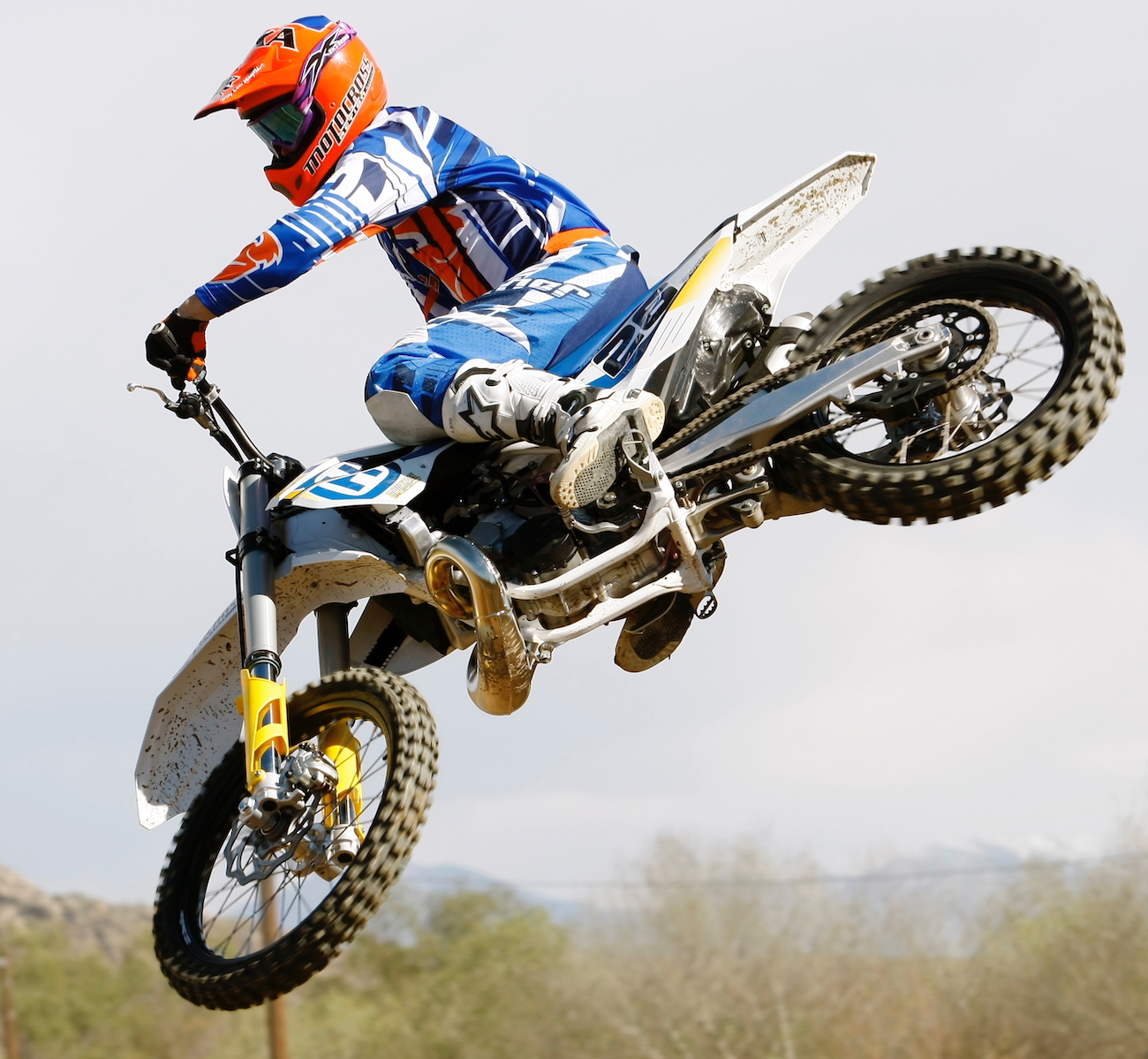

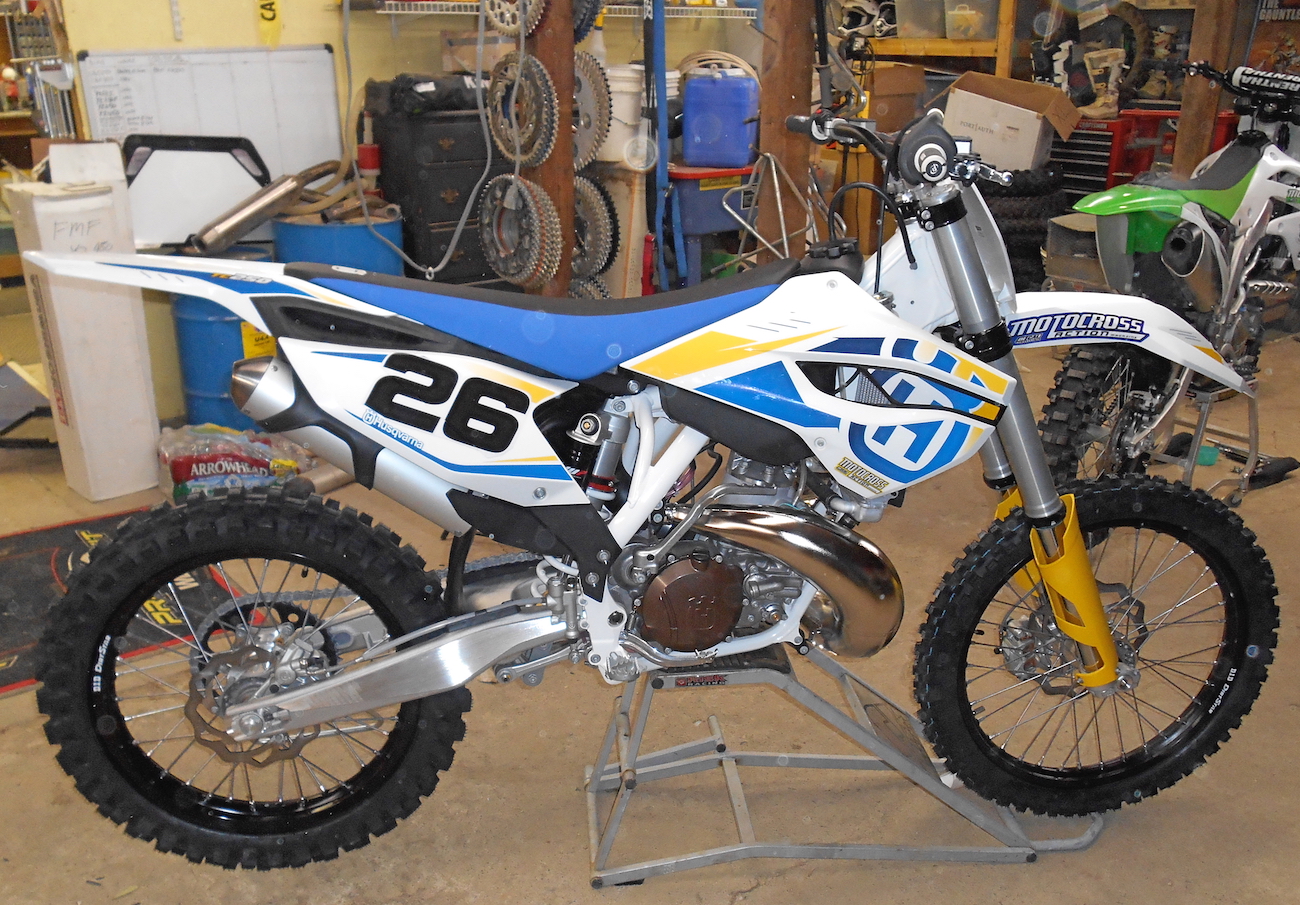

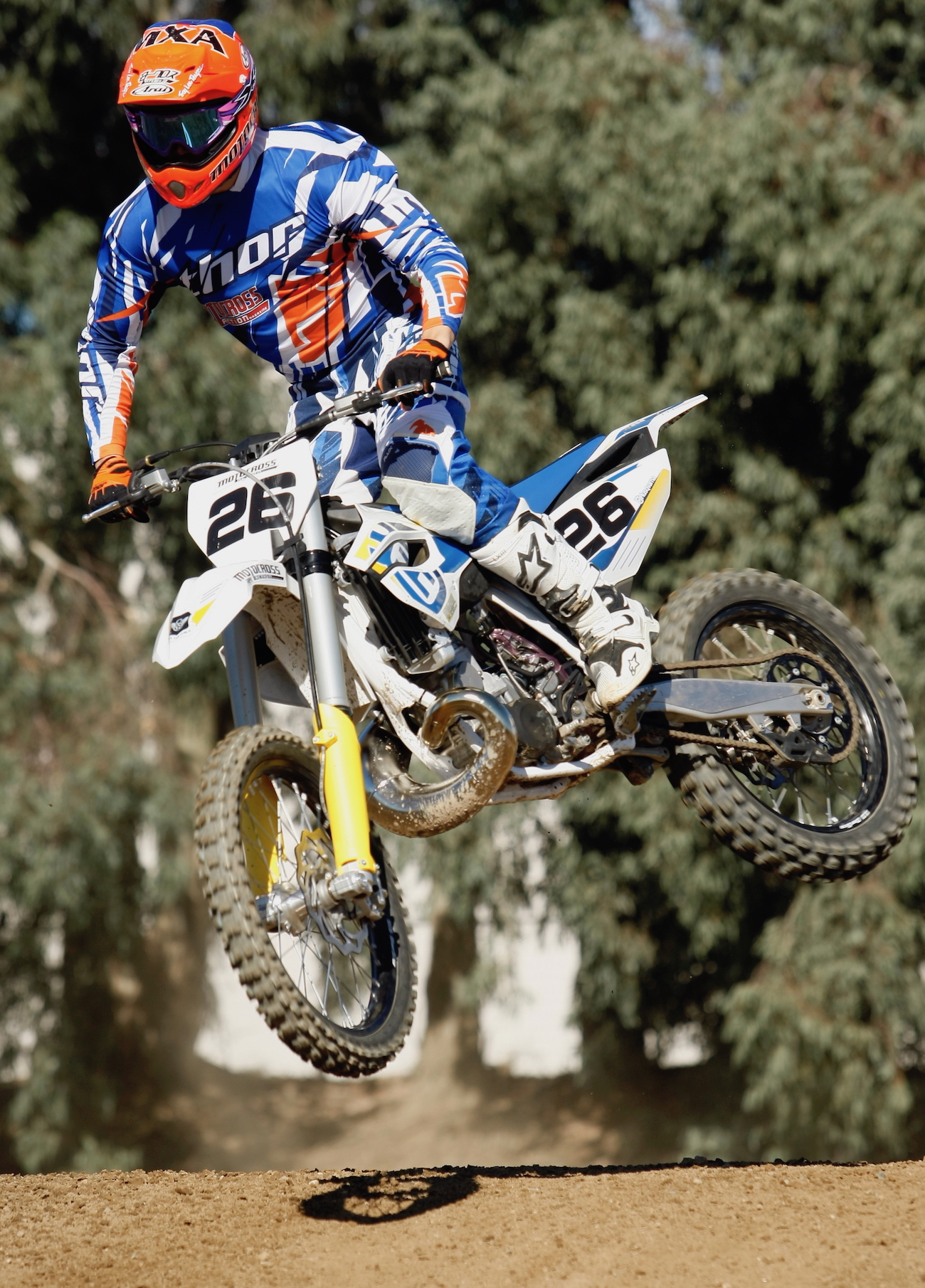
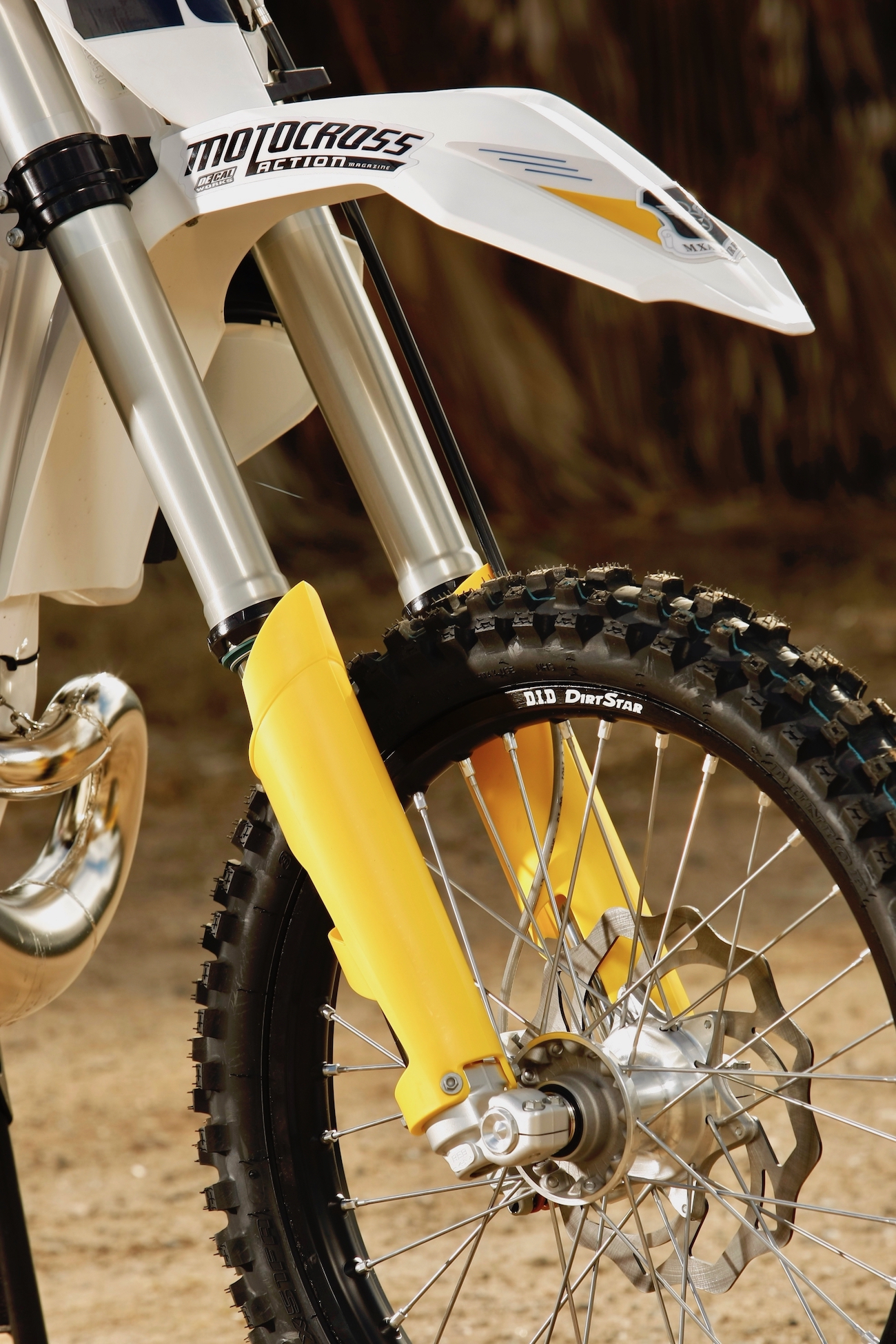
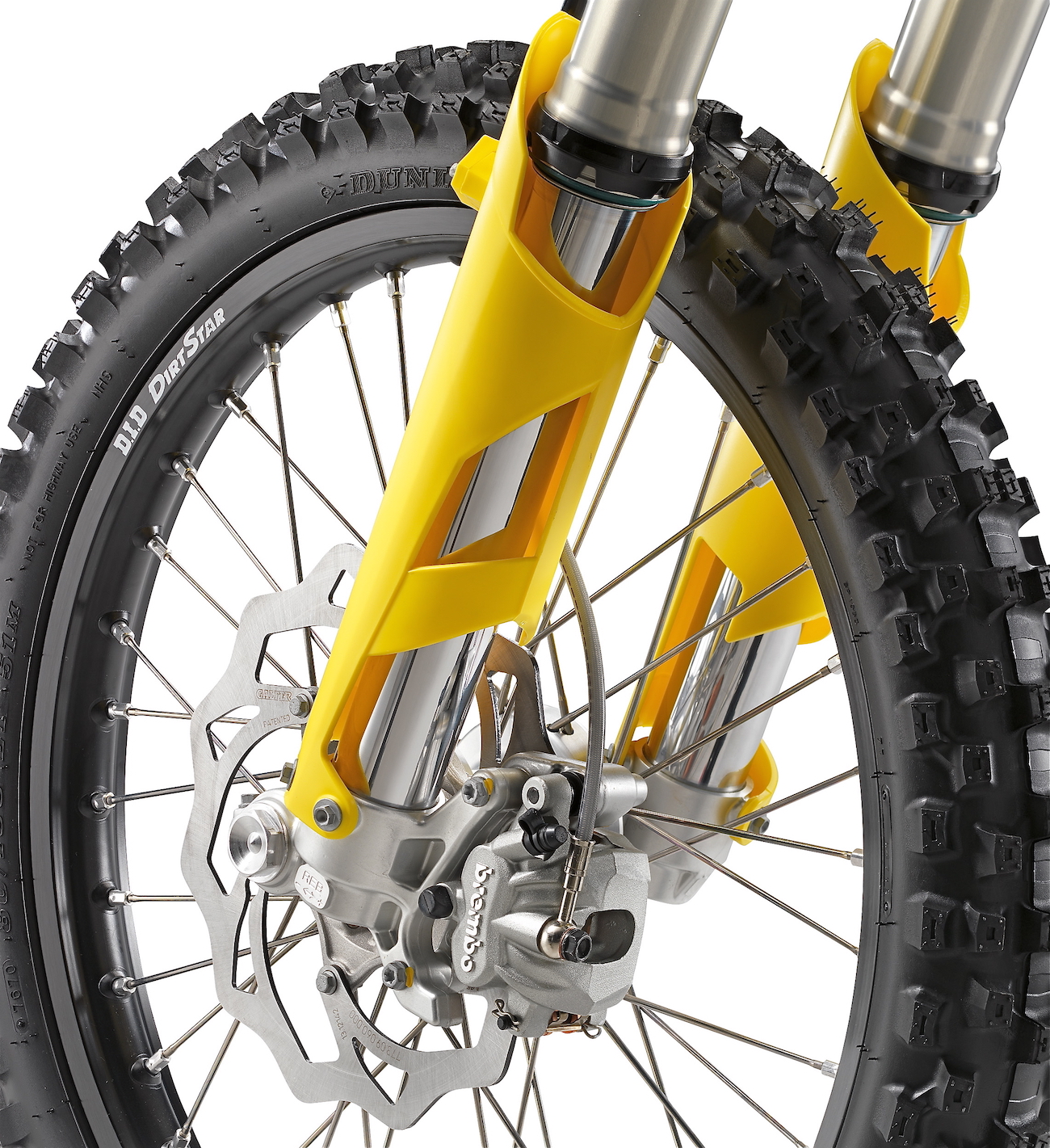




Comments are closed.